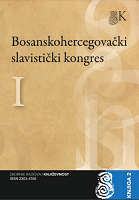Univerzalizam bosanskohercegovačkog sonetarija u okviru estetskog kanona južnoslavenske sonetistike
Universalism of Bosnian-Herzegovinian Sonnetarium in the Frames of Esthetic Canon of South Slavic Sonnet System
Author(s): Vildana PečenkovićSubject(s): Comparative Study of Literature, Bosnian Literature, Theory of Literature, History of Art
Published by: Slavistički komitet BiH
Keywords: Sonnet; Bosnian-Herzegovinian poetry; tradition; modernism;
Summary/Abstract: Unlike other national literatures, in which sonnet form ‘bloomed’ back in the 15th century, it massively appears much later in the South Slavic cultural area, in beginning sporadically and with no special echo. Although it is considered that the first sonnets were written around the year 1230 in Sicily, in the castle of Friedrich II, it was first Francesco Petrarca / Francis Petrarch’s poetry which stylistically defined this strictly shaped poetical form. The appearance of sonnet in other European literatures, as well as in the South Slavic interliterary community, is inseparable from the influence of Petrarch and Petrarcism. This influence is most recognizable in the sonnets by Slovenia’s poet France Prešeren. They are only few poets in Bosnian-Herzegovinian literature who used this demanding form in their literary work. Staring from Musa Ćazim Ćatić, whose poetic work marks specific adoption and reception of sonnet as a European poetical form in Bosniak / Bosnian-Muslim literature, through Aleksa Šantić, Jovan Dučić and, later, Skender Kulenović, sonnets have been presenting a poetic model in which the most intimate poet’s feelings, but also collective impressions of the world are expressed. Unlike other poets of the South Slavic cultural area, Bosnian-Herzegovinian poets considered two kinds of existence: collective and individual, social and poetical ones, and their sonnets reveal poets with roots deep in their homeland. In the contrasts of such manifestations, the poets equalize the past with the present, life and death, beings and objects, dialoging with the time and space in which they exist in this way. That is how poetry doesn’t go back to tradition, but it develops tradition from the perspective of contemporariness to which it belongs.
Journal: Bosanskohercegovački slavistički kongres
- Issue Year: I/2012
- Issue No: 2
- Page Range: 427-438
- Page Count: 12
- Language: Bosnian

